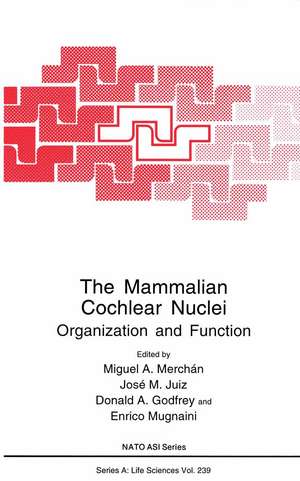The Mammalian Cochlear Nuclei: Organization and Function: NATO Science Series A:, cartea 239
Editat de Miguel A. Merchán, Jose M. Juiz, Donald A. Godfrey, Enrico Mugnainien Limba Engleză Paperback – 20 mar 2012
Din seria NATO Science Series A:
- 15%
 Preț: 656.58 lei
Preț: 656.58 lei - 15%
 Preț: 655.13 lei
Preț: 655.13 lei - 15%
 Preț: 678.35 lei
Preț: 678.35 lei -
 Preț: 397.38 lei
Preț: 397.38 lei - 5%
 Preț: 377.87 lei
Preț: 377.87 lei -
 Preț: 397.76 lei
Preț: 397.76 lei - 18%
 Preț: 1232.41 lei
Preț: 1232.41 lei - 5%
 Preț: 731.64 lei
Preț: 731.64 lei -
 Preț: 413.15 lei
Preț: 413.15 lei - 15%
 Preț: 649.22 lei
Preț: 649.22 lei - 5%
 Preț: 369.45 lei
Preț: 369.45 lei -
 Preț: 407.56 lei
Preț: 407.56 lei - 5%
 Preț: 2162.19 lei
Preț: 2162.19 lei -
 Preț: 407.39 lei
Preț: 407.39 lei -
 Preț: 396.40 lei
Preț: 396.40 lei - 15%
 Preț: 663.93 lei
Preț: 663.93 lei -
 Preț: 387.38 lei
Preț: 387.38 lei -
 Preț: 393.13 lei
Preț: 393.13 lei -
 Preț: 398.35 lei
Preț: 398.35 lei -
 Preț: 401.24 lei
Preț: 401.24 lei - 15%
 Preț: 678.81 lei
Preț: 678.81 lei -
 Preț: 395.09 lei
Preț: 395.09 lei - 18%
 Preț: 952.40 lei
Preț: 952.40 lei - 15%
 Preț: 654.43 lei
Preț: 654.43 lei -
 Preț: 402.00 lei
Preț: 402.00 lei -
 Preț: 401.24 lei
Preț: 401.24 lei - 15%
 Preț: 655.27 lei
Preț: 655.27 lei -
 Preț: 394.71 lei
Preț: 394.71 lei -
 Preț: 384.48 lei
Preț: 384.48 lei - 5%
 Preț: 395.61 lei
Preț: 395.61 lei - 5%
 Preț: 1421.57 lei
Preț: 1421.57 lei - 15%
 Preț: 651.34 lei
Preț: 651.34 lei -
 Preț: 400.10 lei
Preț: 400.10 lei -
 Preț: 386.99 lei
Preț: 386.99 lei - 5%
 Preț: 386.11 lei
Preț: 386.11 lei -
 Preț: 403.91 lei
Preț: 403.91 lei - 15%
 Preț: 651.51 lei
Preț: 651.51 lei -
 Preț: 393.90 lei
Preț: 393.90 lei - 5%
 Preț: 376.43 lei
Preț: 376.43 lei -
 Preț: 400.26 lei
Preț: 400.26 lei - 5%
 Preț: 388.84 lei
Preț: 388.84 lei -
 Preț: 400.65 lei
Preț: 400.65 lei - 5%
 Preț: 740.58 lei
Preț: 740.58 lei - 18%
 Preț: 1225.16 lei
Preț: 1225.16 lei - 5%
 Preț: 386.46 lei
Preț: 386.46 lei -
 Preț: 421.82 lei
Preț: 421.82 lei
Preț: 390.33 lei
Preț vechi: 410.88 lei
-5% Nou
Puncte Express: 585
Preț estimativ în valută:
74.70€ • 77.70$ • 61.67£
74.70€ • 77.70$ • 61.67£
Carte tipărită la comandă
Livrare economică 15-29 aprilie
Preluare comenzi: 021 569.72.76
Specificații
ISBN-13: 9781461362739
ISBN-10: 1461362733
Pagini: 556
Ilustrații: 532 p.
Dimensiuni: 178 x 254 x 29 mm
Greutate: 0.95 kg
Ediția:Softcover reprint of the original 1st ed. 1993
Editura: Springer Us
Colecția Springer
Seria NATO Science Series A:
Locul publicării:New York, NY, United States
ISBN-10: 1461362733
Pagini: 556
Ilustrații: 532 p.
Dimensiuni: 178 x 254 x 29 mm
Greutate: 0.95 kg
Ediția:Softcover reprint of the original 1st ed. 1993
Editura: Springer Us
Colecția Springer
Seria NATO Science Series A:
Locul publicării:New York, NY, United States
Public țintă
ResearchCuprins
The cellular basis for signal processing in the mammalian cochlear nuclei.- I. Developmental Issues.- Cell birth, formation of efferent connections, and establishment of tonotopic order in the rat cochlear nucleus.- Postnatal development of auditory nerve projections to the cochlear nucleus in Monodelphis Domestica.- II. Primary Inputs.- Anatomical and physiological studies of type I and type II spiral ganglion neurons.- Topographic organization of inner hair cell synapses and cochlear spiral ganglion projections to the ventral cochlear nucleus.- Ultrastructural analysis of synaptic endings of auditory nerve fibers in cats: correlations with spontaneous discharge rate.- III. Intrinsic Connections.- Intrinsic connections in the cochlear nuclear complex studied in vitro and in vivo.- The synaptic organization of the ventral cochlear nucleus of the cat: the peripheral cap of small cells.- Alterations in the dorsal cochlear nucleus of cerebellar mutant mice.- IV. Descending Projections.- Non-cochlear projections to the ventral cochlear nucleus: are they mainly inhibitory?.- Non-primary inputs to the cochlear nucleus visualized using immunocytochemistry.- Superior olivary cells with descending projections to the cochlear nucleus.- Descending projections from the inferior colliculus to the cochlear nuclei in mammals.- V.- Neurotransmitters of the Cochlear Nucleus.- Localizing putative excitatory endings in the cochlear nucleus by quantitative immunocytochemistry.- Excitatory amino acid receptors in the rat cochlear nucleus.- Glycine and GABA: transmitter candidates of projections descending to the cochlear nucleus.- Inhibitory amino acid synapses and pathways in the ventral cochlear nucleus.- Glycinergic inhibition in the cochlear nuclei: evidence for tuberculoventral neuronsbeing glycinergic.- GABA and glycine inputs control discharge rate within the excitatory response area of primary-like and phase-locked AVCN neurons.- Neuropharmacological and neurophysiological dissection of inhibition in the mammalian dorsal cochlear nucleus.- Comparison of quantitative and immunohistochemistry for choline acetyltransferase in the rat cochlear nucleus.- Choline acetyltransferase in the rat cochlear nuclei: immunolocalization with a monoclonal antibody.- VI. Projections and Response Properties of Cochlear Nucleus Neurons.- The cochlear root neurons in the rat, mouse and gerbil.- Projections of cochlear nucleus to superior olivary complex in an echolocating bat: relation to function.- The monaural nuclei of the lateral lemniscus: parallel pathways from cochlear nucleus to midbrain.- Ascending projections from the cochlear nucleus to the inferior colliculus and their interactions with projections from the superior olivary complex.- Responses of cochlear nucleus cells and projections of their axons.- Physiology of the dorsal cochlear nucleus molecular layer.- Coding of the fundamental frequency of voiced speech sounds and harmonic complexes in the cochlear nerve and ventral cochlear nucleus.- VII. Computer Modelling of the Cochlear Nucleus.- Computer modelling of the cochlear nucleus.- Regularity of discharge constrains models of ventral cochlear nucleus bushy cells.- Cross-correlation analysis and phase-locking in a model of the ventral cochlear nucleus stellate cell.- VIII. Appendix: Cochlear Nucleus Prostheses.- The development and evaluation of cochlear nucleus prostheses.- IX. Special Contributions in Honour of R. Lorente de Nó.- Lorente de Nó’s scientific life.- Sensoritopic and topologic organization of the vestibular nerve.- Lorente de Nóand the hippocampus: Neural modeling in the 1930s.- The rat entorhinal cortex. Limited cortical input, extended cortical output.- Axonal patterns of interneurons in the cerebral cortex: in memory of Rafael Lorente de Nó.- Glomérulos, barrels, columns and maps in cortex: an homage to Dr. Rafael Lorente de Nó.- Lorente de Nó: the electrophysiological experiments of the latter years.












